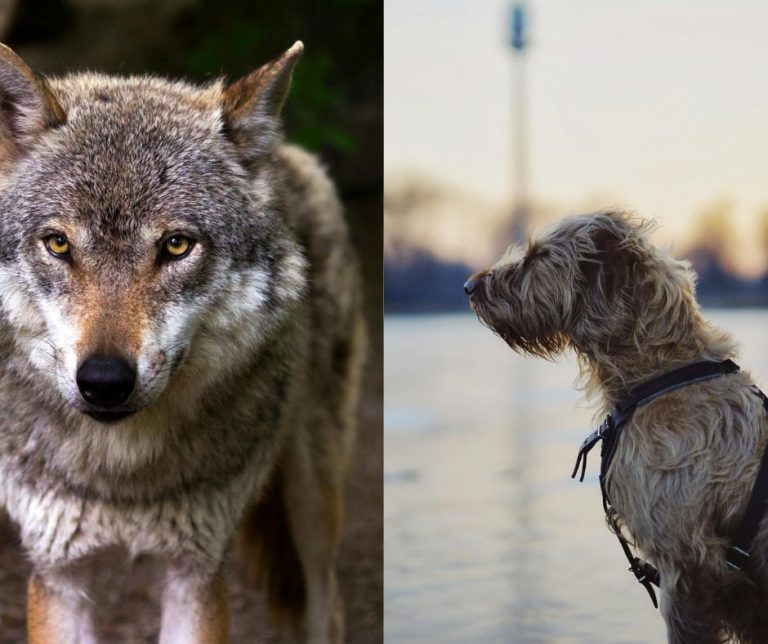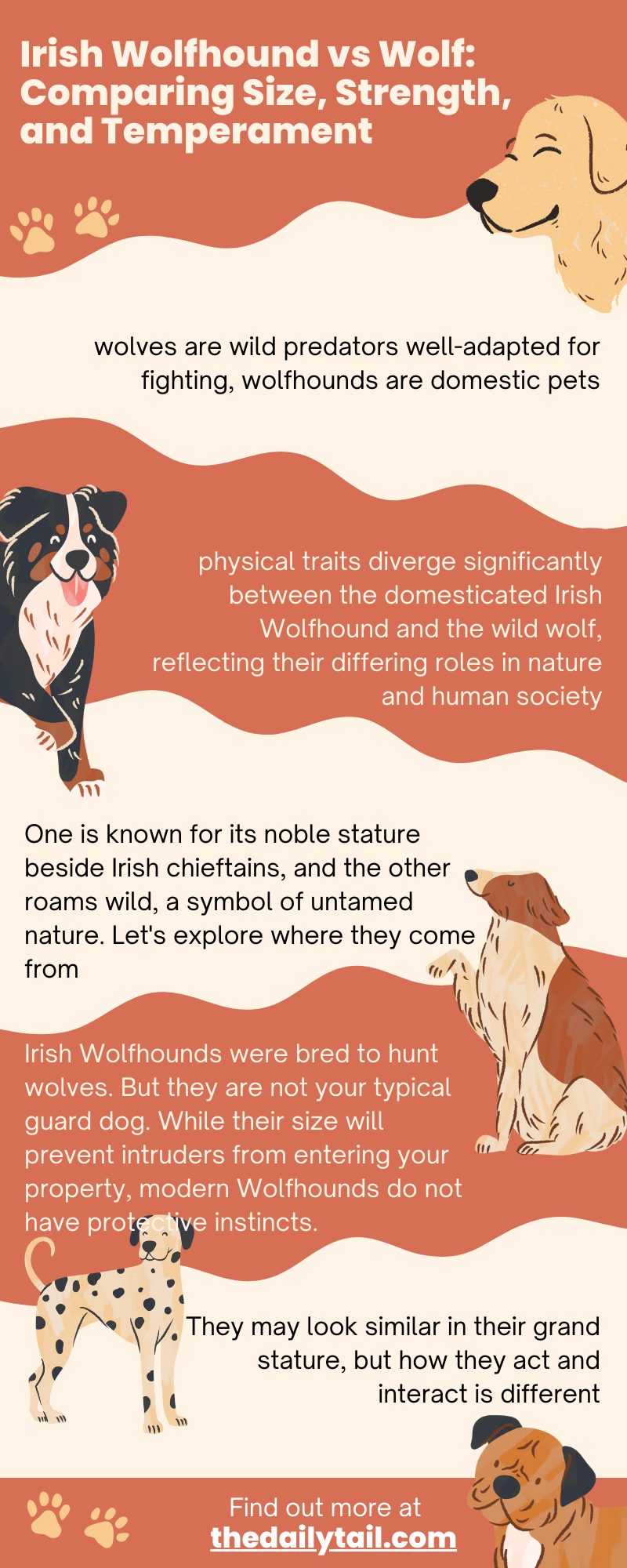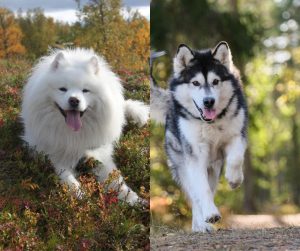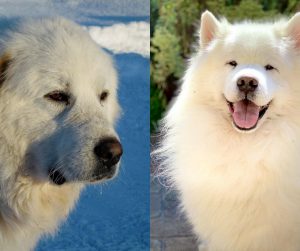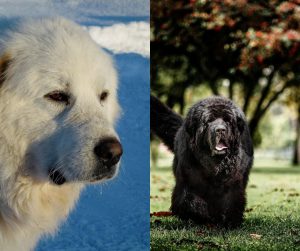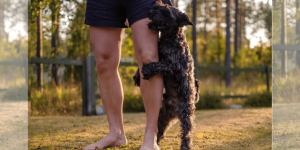Irish Wolfhounds were bred to hunt wolves. But can they still do it nowadays? Have we domesticated these dogs to a point they are pets and not a loyal hunting companion?
When we talk about Irish Wolfhound vs Wolf, and who would win in a potential fight, we have to consider many factors. Nowadays, the Irish Wolfhound is a domesticated dog breed, well-known for its towering stature and friendly demeanor. It was originally bred to chase and hunt wolves in Ireland, which speaks volumes about its capabilities.
On the other hand, wolves are wild animals, known for their sharp survival instincts and pack behavior, which have played a significant role in ecosystems across various habitats.
The history and ancestry of these two are as distinct as their physical build.
Irish Wolfhounds have been the companions of humans for centuries, their existence intertwined with our own stories and societies. In contrast, wolves have roamed the wild, often standing as symbols of nature’s untamed spirit.
Visually distinguishing an Irish Wolfhound from a wolf is usually straightforward: the former typically displays floppy ears and a shaggier appearance, while the latter features upright ears and a leaner physique.
While both are large, their body structure and proportions differ, with the wolf often being leaner and longer-legged, whereas the Irish Wolfhound tends to have a bulkier build.
Key Takeaways
- The Irish Wolfhound, though originally bred to hunt wolves, is vastly different from its wild counterpart in behavior and appearance
- Ancestral and physical traits diverge significantly between the domesticated Irish Wolfhound and the wild wolf, reflecting their differing roles in nature and human society
- While Irish Wolfhounds are gentle giants suitable as pets, wolves exhibit natural instincts and behaviors that are intrinsic to their survival in the wild
History and Ancestry
When we talk about history, these two animals have unique background. One is known for its noble stature beside Irish chieftains, and the other roams wild, a symbol of untamed nature. Let’s explore where they come from.
Origins of the Irish Wolfhound
Irish Wolfhounds, with their towering height and gracious presence, trace back to ancient Ireland. They were esteemed by chieftains and often featured as prized guardians and hunters.
The breed’s history is well documented, with notable recognition coming from ancient Rome. In 391 AD, a Roman consul expressed his awe at receiving these hounds as gifts, conveying their prestige back home.
The breed’s survival was later bolstered thanks to efforts by Captain George Augustus Graham in the 19th century, who worked diligently to preserve the Irish Wolfhound of old.
Evolution of Wolves
Meanwhile, wolves are wild ancestors of domestic dogs. They have a history that spans across hundreds of thousands of years. Shrouded in mystery and often misunderstood, wolves have existed long before the domains of humans expanded into their territories.
Wolves were once widespread, with the last wolf in Ireland thought to have been seen in the 18th century. The story of Gelert, a legendary hound often conflated with the Irish Wolfhound, highlights the complex relationship between humans and canines, whether domesticated like the Wolfhound or wild like the wolf.
Physical Characteristics
When you look at physical appearance comparison of Irish Wolfhound vs wolf, it’s like comparing a gentle giant with a wild, athletic cousin. Both have their own unique set of features that set them apart, which we will explore in this section.
Size and Appearance
The Irish Wolfhound stands tall and proud with an average height ranging from 30 to 36 inches. These pooches are no lightweights either; they tend to weigh a solid 130 to 160 pounds. Their appearance is marked by a shaggy, rough coat, and they can be found in colors like gray, brindle, black, white, fawn, and red.
These are breed standards set by the American Kennel Club. Many years ago, before official recognition, the Irish Wolfhound was bred to be bigger and bigger. There was not set standard, as the dog was a hunting companion, not a pet. Nowadays, the American Kennel Club sets a standard for the giant breed.
Compared to the Irish Wolfhound, a wolf generally has a shorter stature, standing at about 24 to 32 inches at the shoulder. Wolves weigh in between 80 to 150 pounds.
They boast a thick, fluffy coat that helps them blend into the wilderness and is primarily found in shades of gray, although colors can vary. And while there are dog breeds that look like wolves, we can never say a wolf is like a dog.
Breed Comparison
The Irish Wolfhound puppy might remind you of a Scottish Deerhound or a Great Dane in terms of size—they’re among the tallest dogs around. However, the wolf is not a breed; it’s a wild animal, and that’s really important to remember. While both can be similar in weight, wolfhounds often have a more significant heft.
When standing side by side, an Irish Wolfhound has a leaner and more elongated body compared to the robust and strong-built frame of a wolf. Both magnificent in their own right, they offer a fascinating look at how nature and nurture shape the physical form of canines.
Temperament and Behavior
When it comes to the Irish Wolfhound and the wolf, their temperament and behavior are worlds apart. They may look similar in their grand stature, but how they act and interact is different.
Nature of Irish Wolfhounds
Irish Wolfhounds are known for their gentle nature, making them excellent companions. They’re huge, yes, but they’ve got hearts as big as their bodies.
They’re not the type to pick a fight; instead, they’re calm and kind, making them a hit with families.
When it comes to kids, these furry giants are patient and careful, even though their size alone could seem a bit overwhelming.
Their intelligence shines through easily in how quickly they pick up on training, especially when treated with respect and patience.
Wolf Pack Mentality
Wolves, on the other hand, stick to their own kind in the wild, living by a pack mentality that demands both respect and a clear order.
The leader calls the shots and aggression can be a part of daily life, especially when it comes to finding food or defending their territory.
It’s not just about being aggressive though; it’s about survival.
Unlike the domesticated Irish Wolfhound, a wolf’s intelligence is more about hunting strategies and understanding complex pack dynamics than sitting for a treat.
Wolves aren’t pets – they’re wild animals that demand a level of understanding and respect of their natural behaviors.
Care and Managing
When you bring an Irish Wolfhound into your home, you’re taking on a big and beautiful buddy that comes with specific needs to keep them healthy and happy. This section will guide you through their diet and nutrition as well as training requirements.
Diet and Nutrition
The Irish Wolfhound is a gentle giant with a big appetite. Their diet should be high-quality dog food appropriate for their large size and high energy level.
- Puppies (up to 2 years): They grow rapidly, so they benefit from a diet that supports bone and muscle development. Here’s what you should be looking for:
- Beef, chicken, or lamb are great meat choices
- Introduce foods gradually to avoid upsetting their stomach
- Puppy food should be specifically for large breeds
- Adults:
- Continue with high-quality large breed food
- They usually eat 4-8 cups of dry food per day, divided into two meals
- Senior dogs:
- Food for seniors helps maintain their health as they become less active
- Watch for weight gain and adjust portions to their activity level
Key Tips:
- Always have fresh water available
- Discuss their diet with a veterinarian to ensure you’re meeting nutritional needs
Training Needs
Training an Irish Wolfhound requires patience and consistency. They are smart dogs with a mind of their own, but they respond well to positive reinforcement.
- Early Days: Begin training as soon as you bring your puppy home. They pick up on habits early, and it helps in avoiding problems later
- Socialization: Expose them to various people, pets, and environments to develop a well-rounded temperament
- Basic Commands: Focus on commands like sit, stay, come, and down. Be firm, but kind
- Consistency is key: Use consistent commands and reward good behavior with treats or praise
Exercise Requirements:
- Irish Wolfhounds need plenty of exercise. Aim for two walks a day
- They have a high prey drive, so outdoor areas must be secure to prevent escapes
Grooming:
-
- Brush their coat weekly to remove dirt and loose fur, and to prevent matting
- Regular vet check-ups will help keep your Irish Wolfhound in top-notch condition
Challenges and Considerations
When comparing Irish Wolfhounds and wolves, it’s important to think about the different needs and issues that come with living with them. This includes thinking about how much room they need and how long they can be expected to be part of the family.
Living Space Requirements
Irish Wolfhounds are not just big, they’re one of the largest breeds around. These gentle giants need plenty of room to stretch their legs and roam.
They’re sighthounds, which means they love to chase; a big, fenced yard is really important. They come from a hunting background, so an apartment won’t cut it—they thrive with space.
Health and Lifespan
On the health front, Irish Wolfhounds are sensitive souls with a lifespan shorter than some other breeds, often between 6 and 8 years.
As family pets, they bring joy for a time that feels too short. They’ve got big hearts, quite literally, and with that, they can face health challenges linked to their size.
Regular vet check-ups are key to keeping them as healthy as possible for as long as possible.
Cultural Impact
Irish Wolfhound in Literature
The Irish Wolfhound has been a noble figure in literature. This big dog often shows up in tales that touch the heart and fire up the imagination.
One famous story is about Gelert, a loyal hound, who got mixed up in a tragic mix-up that taught folks about trust and sacrifice.
Poetry isn’t left out of this dog’s story, either. These gentle giants are often praised for their grace and strength in poems that are easy to read and feel—just like talking to a wise old friend.
Wolves in Mythology
Wolves have quite the part to play in mythology. They’re wild and free and often show up as powerful symbols in stories from long ago.
People have been telling tales around fires of how these animals move through the natural world. Each step is full of mystery and maybe a bit of magic.
In Irish myths, like the ones about the hero Cú Chulainn, wolves pop up now and again. They weave through our legends, sometimes as fearsome challenges, other times as guides or symbols of untamed nature.
For a bit of living history, the Irish Guards, part of the British Army, have a mascot that’s an Irish Wolfhound. It’s a nod to the dog’s sturdy character and the folklore that surrounds these grand animals.
They even march in parades, which is quite the sight!
On the rugby field, the presence of wolves and hounds might not be literal, but you can bet the spirit of these animals lives on.
Teams often take on their traits—strong, protective, and fierce. Just like the literature they’ve inspired, they capture the essence of what it means to be a force of nature.
Frequently Asked Questions
Do Irish Wolfhounds hunt wolves?
As we talked earlier, the Irish Wolfhound dog breed was bred to be a wolf hunter. Many years ago, people needed somebody to protect them from wolves. And that is how they came up with the idea of the Irish Wolfhound.
Fun fact: these dogs also hunt wild boar and deer. As legendary dogs of Scottish people and other tribes from Northern Britain, Irish Wolfhounds were among the most popular hunters. Of course, that group also includes the Scottish Deerhound, another giant dog.
Will an Irish Wolfhound protect you?
Irish Wolfhounds were bred to hunt wolves. But they are not your typical guard dog. While their size will prevent any potential intruders from entering your property, modern Wolfhounds do not have protective instincts.
They might defend the pack if necessary, but they are more likely to greet newcomers. These dogs were bred to accompany hunters and hunt on command. Not to protect the property and bark.
Who is bigger?
The Irish Wolfhound is among the largest dogs in the world, along the likes of Mastiff, Great Dane, and Scottish Deerhound. Yet, a male gray wolf might weight up to 175 pounds. I have to say, that is a rarity.
Wolves might reach that size in the wild, but it is quite rare. Typically, male wolves weigh between 90 and 100 pounds. Females weigh between 70 and 80 pounds.
An adult Irish Wolfhound weighs between 120 and 180 pounds.
Can a wolfhound beat a wolf?
Irish Wolfhounds haven’t been used for wolf hunting for many years. But in a hypothetical battle, yes, they can beat a wolf. But there are many factors that we should consider. For starters, size, strength, and health of both animals.
We also have to take into account the fighting experience. Wolves live in the wild, and they often battle for food or something else. Wolfhounds are nowadays domestic pets. So, while wolves are wild predators well-adapted for fighting, wolfhounds are domestic pets.
Then, we also have to consider that wolves are famous for their agility, strength, and pack-hunting tactics. It gives them a huge advantage in combat situations.

